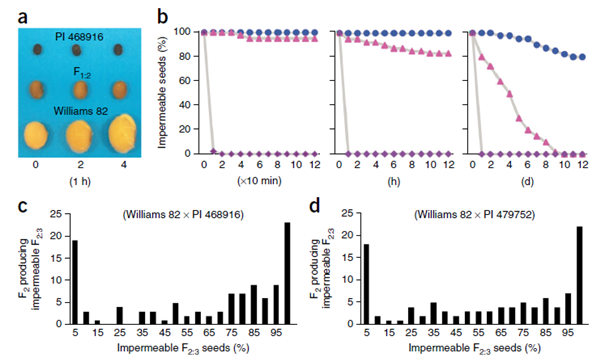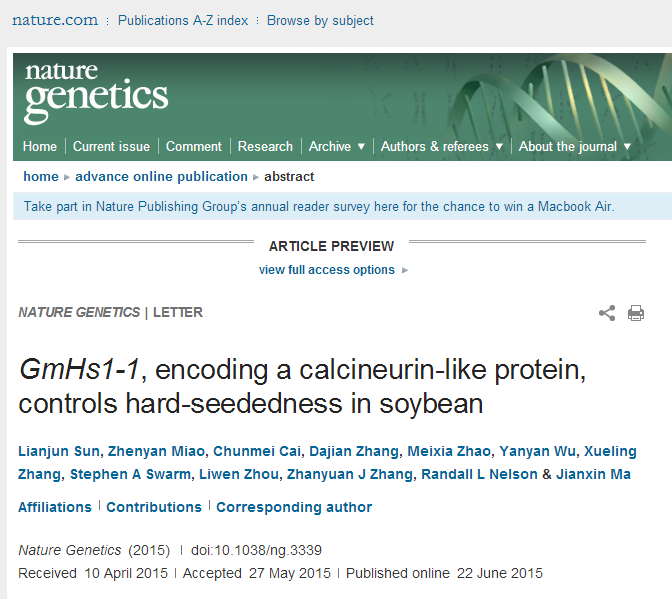Scientific Research Team of QAU Clones out Hard-seededness Gene of Soybean Coat
2015-07-11 15:46:33 views:0


The scientific research team of Crop Application Genome of the School of Life Sciences, Qingdao Agricultural University(QAU) has successfully cloned out the major gene named GmHs1-1 that controls the hard-seededness of soybean coat. On June 22nd, 2015, the academic paper titled The calcineurin-like gene GmHs1-1 controls hard seededness in soybean was published online in Nature Genetics, a top international academic journal. The impact factor of this paper reaches up to 33.463. This research was finished by Purdue University in collaboration with three other universities, that is, QAU, University of Illinois and University of Missouri. Dr. Ma Jianxin, a Shandong Tarzan scholar of QAU, is the corresponding author, and Dr. Cai Chunmei is listed as one of the parallel first authors.
The hard-seededness of seed coat is a very important property for wild leguminosae plants, since it can help maintain the seeds’ dormancy and vitality for a long time. However, the hard-seededness is unfavorable to seed germination, which thus hinders the effective utilization of wild soybeans in the germplasm innovation and the mass propagation of soybean seeds. Therefore, the imbibition of seed coat has become one of the important target properties of the artificial acclimation of leguminous plants. Besides, the hard-seededness also has something to do with the content of calcium in the seed coat, which can increase the nutritional value of soybean products. So far, except for the discovery of QTL in chromosome 2, which is relevant to the soybean’s hard-seededness, genes controlling this trait has never been cloned out in any plants.
The scientific research team led by Doc. Ma Jianxin have made unremitting efforts for many years and finally identified the only major gene namely GmHs1-1 that controls hard seededness in soybean with the method of map-based cloning. This gene encoding of calcium phosphate phosphatase trans-membrane protein is located in cell membrane. The gene of GmHs1-1 is mainly expressed in the palisade layer of seed coat, and has some bearing on the content of calcium in the seed coat. Based on analysis of the coding sequence of this very gene in wild soybeans and Williams82, it is discovered that the artificial selection of a point mutation in GmHs1-1 leads to the transformation of seed coat from hard seededness to imbibition. The amino acid altered by this point mutation is situated outside the cell membrane and has an impact upon the α-helical structure of protein, which thus results in the weakening or loss of function of this gene. Although plenty of non-hard local varieties are artificially selected during the acclimatization process of cultivated soybean, a fraction of local varieties get rid of the artificial selection of non-hard seededness owing to the rupturing property of seed coat, because the rupture of seed coat can also overcome the problem of hard-seededness, which then makes the seeds imbibe and germinate. Although being the sole source of the transformation of seed coat from hard seededness to imbibition, the single-base mutation might have experienced a second or multiple selections due to the interpenetration of genetic materials between wild soybean and cultivated soybean.
This paper makes clear the mutation types of the hard seed coat gene of wild and cultivated soybean, which provides an efficient identification method for the marker-assisted selection of hard and imbibition resources and also throws light on the gene mutation of soybean released cultivars during the artificial selection. This research will accelerate the identification process of the gene that controls this trait as for other soybean plants.
Translated by Ding Shuting
Web Link: http://www.nature.com/ng/journal/vaop/ncurrent/full/ng.3339.html
Qingdao Agricultural University
About QAU | | Research | International | Alummi | Study At QAUAddress:No. 700 Changcheng Road, Chengyang, Qingdao, Shandong, China. P.C. 266109
Web Design: News Center of Qingdao Agricultural University.




